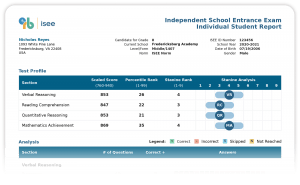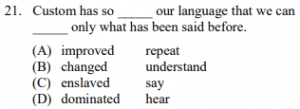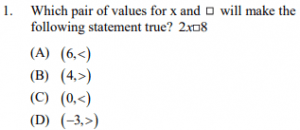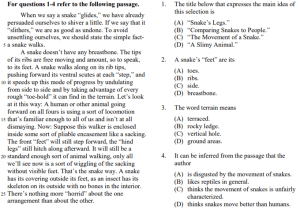
ISEE Exam Guide: All About the Upper Level ISEE Exam
Welcome to the fifth part of MEK’s Exam Guide series, where we are covering all of the major exams we offer to provide you with a clearer understanding of each test’s parts, how they are scored, and set some baseline expectations. The last part of our series covered the SSAT, one of the exams commonly used for admission into many prestigious private schools. Today, we’ll be covering the other option for students: the ISEE. Specifically, this guide will cover the upper level of the exam, which is mainly used as a private high school admission test.
General Upper Level ISEE Exam Information
As stated above, the ISEE serves primarily as private high school admission tests for students currently in grades 8-11. The test generally examines how a student thinks and measures what they have learned from their earlier time in school.
The ISEE takes a total of 2 hours and 40 minutes to complete along with 2 break periods included within. They also provide students with a variety of options in how they take the exam, whether that be on paper, at home, or at a separate testing center. One important thing to note is that there are individual testing fees that start at a baseline of around $125 and can go as high as around $240.
For the ISEE, the timing of each section is as follows:
-
- Part 1 – Verbal Reasoning – 20 minutes, 40 questions
- Part 2 – Quantitative Reasoning – 35 minutes, 37 questions
- Part 3 – Break – 5-10 minutes
- Part 4 – Reading Comprehension – 35 minutes, 36 questions
- Part 5 – Mathematics Achievement – 40 minutes, 47 questions
- Part 6 – Break – 5-10 minutes
- Part 7 – Essay – 30 minutes, 1 prompt
How the ISEE is Scored
The ISEE consists of four sections: Verbal Reasoning, Reading Comprehension, Quantitative Reasoning, and Mathematics Achievement. Each of these sections is scored out of range from 760 to 940 based on the raw score and a scaling process. From these scaled scores, students are also provided with various further analyses, such as a percentile rank as well as a stanine rank and analysis. The Percentile Rank tells us how the student performed in comparison to other students, with a higher percentile equating to better performance overall. The Stanine Rank is another method of comparison that categorizes students into subgroups based on performance, with a higher number of 9 representing the top group and a lower number of 1 being the lower performers.
Beyond these statistical analyses, the ISEE also provides further breakdown of the number of questions in each section along with how the student performed on each.
The following is an example of what a score report for the ISEE could look like.

For more information on the ISEE scoring methods and test as well, please check out the ISEE’s website here.
The Differences Between Each ISEE Section
Now, we’ll take a closer look at each of the sections within the ISEE, understanding the differences in structure as well as providing some examples of questions from each part.
Verbal Reasoning
This section has two types of questions: vocabulary and sentence completion. For the vocabulary questions, students are provided a word along with four word choices. They must choose the word that most accurately matches the provided word’s definition. For the sentence completion questions, students are given a sentence with a missing word or pair of words along with four answer choices. Again, they must choose the option that most appropriately completes the context of the sentence.
The following is an example problem for the verbal reasoning section.
Quantitative Reasoning
The next section of the exam is quantitative reasoning, which includes word problems and quantitative comparisons. In essence, this is a math section but differs in that the word problems require either no calculation or only simple calculations. For the quantitative comparison questions, students are given two different quantities and then asked to select one of the four following answer choices:
-
- The quantity in A is greater
- The quantity in B is greater
- The two quantities are equal
- The relationship cannot be determined from the information given
The following are some examples of what each of the two types of questions might look like.
Reading Comprehension
For this section, students are given six reading passages and sets of related questions. Each of these passages contains modern information and cover age relevant subjects. Topics covered include arts, contemporary life, history, and science.
The following is what a passage and some questions might look like from this section.
Mathematics Achievement
The final math section is more traditional, following national mathematics standards. Students must identify the problem and find a solution to the problem, which can require one or more steps sometimes.
The following are some sample problems showing what the section could look like.
The Essay
The final part of the ISEE is the written essay. Students are provided with a prompt designed for an informed essay on a specific topic. These prompts are one to two sentences in length and describe a situation for the student to respond to. These essays are NOT scored and instead are sent directly to schools along with the rest of the test scores.
How Can You Begin to Prepare for the Upper Level ISEE?
After learning more about the ISEE, the next step is to determine whether this is the right test for you. As mentioned in our previous article, students that don’t like the structure of the ISEE have the option of choosing the SSAT for their private high school admissions exam. While this does depend on whether the intended school accepts each exam, a majority of the most well-known schools do take both. If you are interested in learning more about the SSAT before making a choice between both exams, please check out our previous blog post here!
However, if you’ve decided that the ISEE sounds like the right choice, MEK offers a variety of programs for students looking for professional and in-depth prep help for their admissions process.
- SSAT/ISEE Group Classes: This course serves to train 8th graders on how to ace the upper level SSAT and ISEE.
- SSAT/ISEE Private Tutoring: Students looking for more individualized instruction can opt for one-on-one tutoring throughout the year with expert instructors.
- SSAT/ISEE Prep 8: This class is similar to our group classes, but only offered in the summer to 8th graders that have already completed MEK’s Exam Prep 8 program.
To learn more about our ISEE programs, please click here to visit our programs page. If you have any other questions or concerns, give us a call at +1 (855) 346-1410 or contact us today!









